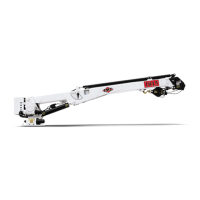99903514:TELESCOPIC CRANE:
2-11 SECTION 2: MAINTENANCE
2-6-5: WIRE ROPE SLINGS
Rated load (rated capacity) of a wire rope sling
is based on the nominal, or catalog, strength of
the wire rope used in the sling, and factors
which affect the overall strength of the sling.
These factors include attachment or splicing
efficiency, the number of parts of rope in the
sling, type of hitch (straight, choker, basket),
diameter around which the body of the sling is
bent, and the diameter of hook over which the
eye of the sling is rigged.
Rated load of a sling is different for each of the
three basic methods of rigging. These rated
loads are available from your wire rope sling
supplier and may be indicated on a tag attached
to the sling at the time it is fabricated.
WARNING
A HAND-TUCKED EYE SPLICE CAN
UNLAY (UNRAVEL) AND FAIL IF THE SLING
IS ALLOWED TO ROTATE DURING USE.
Never shock load a sling. You cannot estimate
the actual force applied by shock loading. The
rated load of a wire rope sling can easily be
exceeded by a sudden application of force, and
damage can occur to the sling. The sudden
release of a load can also damage a sling.
Protect the wire rope body against damage
using corner protectors, blocks or padding.
Sharp bends that distort the sling body damage
the wire rope and reduce its strength.
Any angle other than vertical at which a sling is
rigged increases the loading on the sling.
Visually inspect slings before each lift or usage
to determine if it is capable of safely making the
intended lift. Inspect wire rope slings in the
same manner as wire rope.
When a sling is found to be deficient, the eyes
must be cut, or other end attachments or fittings
removed to prevent further use, and the sling
body discarded.
A sling eye should never be used over a hook or
pin with a body diameter larger than the natural
width of the eye. Never force an eye onto a
hook. The eye should always be used on a
hook or pin with at least the diameter of the
rope.
BASIC HITCHES
VERTICAL or straight attachment, is simply the
using of a sling to connect a lifting hook to the
load. Full rated load of the sling may be used,
but never exceeded. A tagline should be used
on such a lift to prevent rotation which can
damage the sling. A sling with a hand-tucked
splice can unlay and fail if the sling is allowed to
rotate.
CHOKER hitches reduce lifting capability of a
sling, since this method of rigging affects the
ability of the wire rope components to adjust
during the lift, places angular loading on the
body of the sling, and creates a small diameter
bend in the sling body at the choke point.
BASKET hitches distribute a load equally
between the two legs of a sling, within limita-
tions imposed by the angles at which legs are
rigged to the load.
Figure B-11: Basic Hitches
20030115

